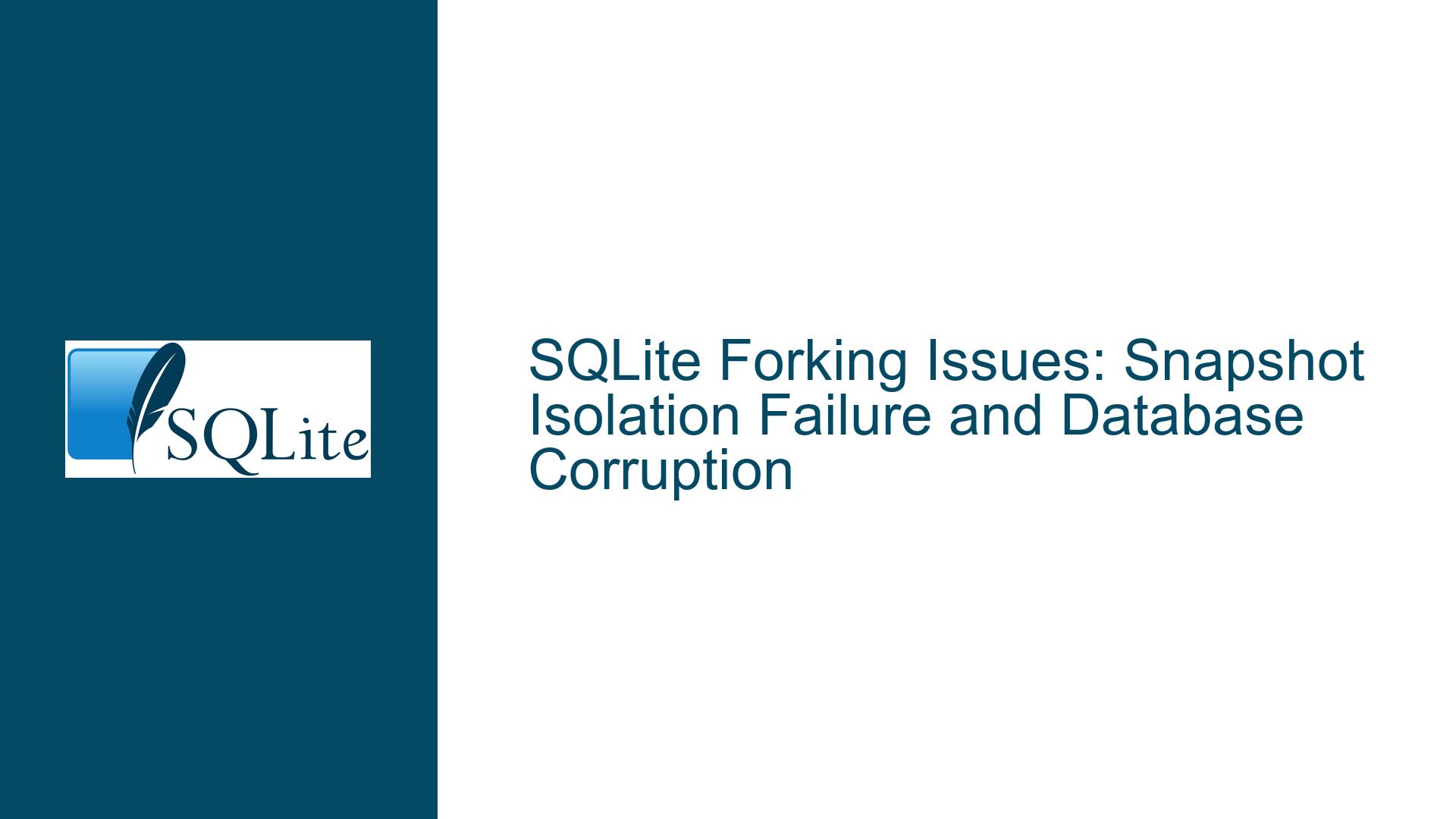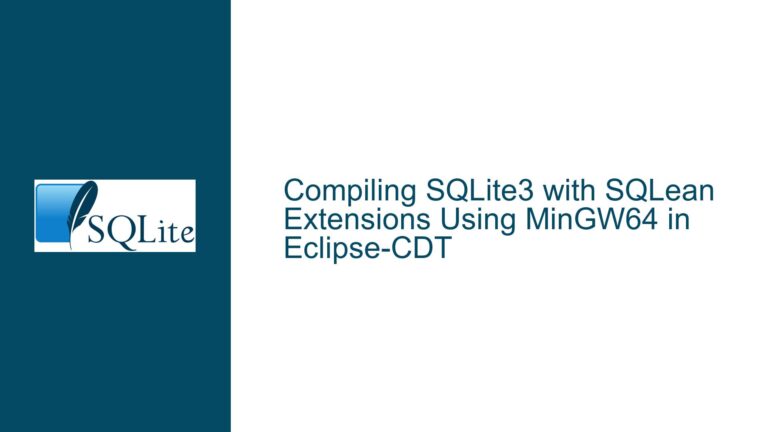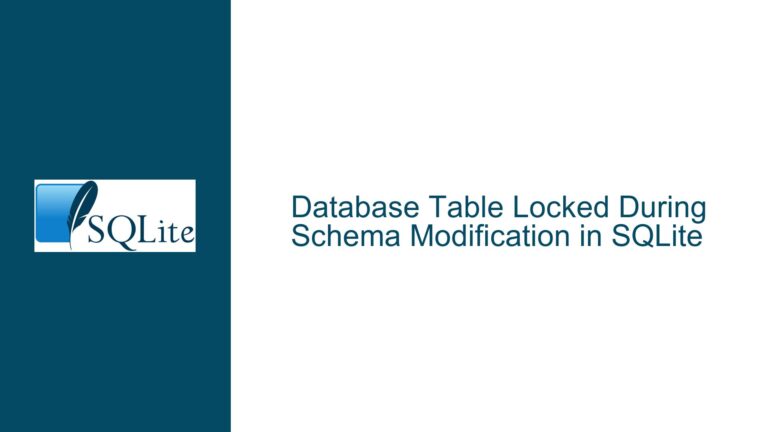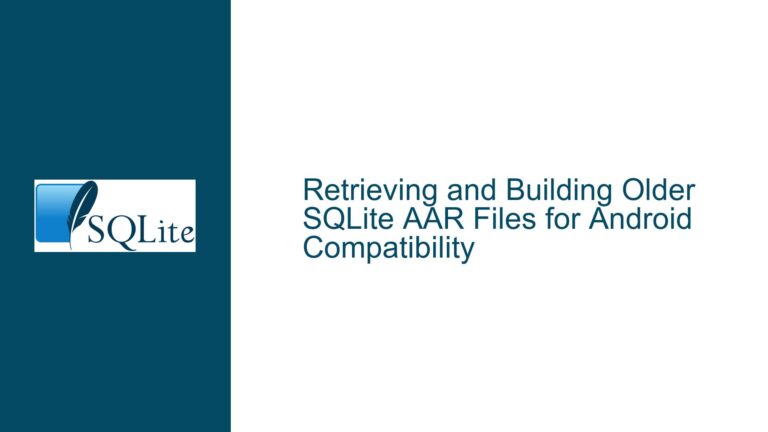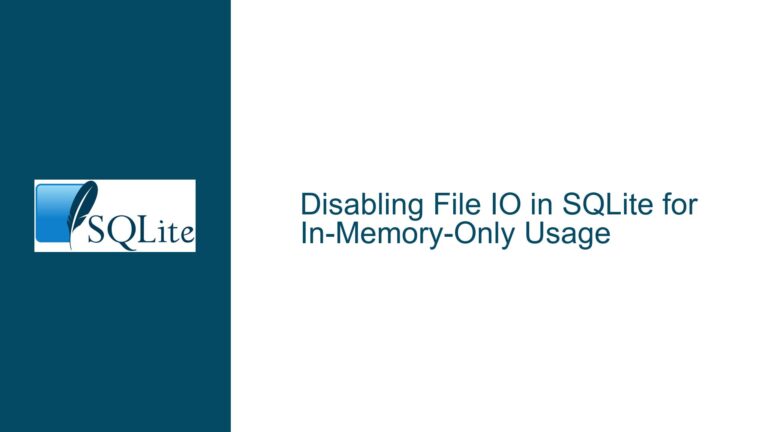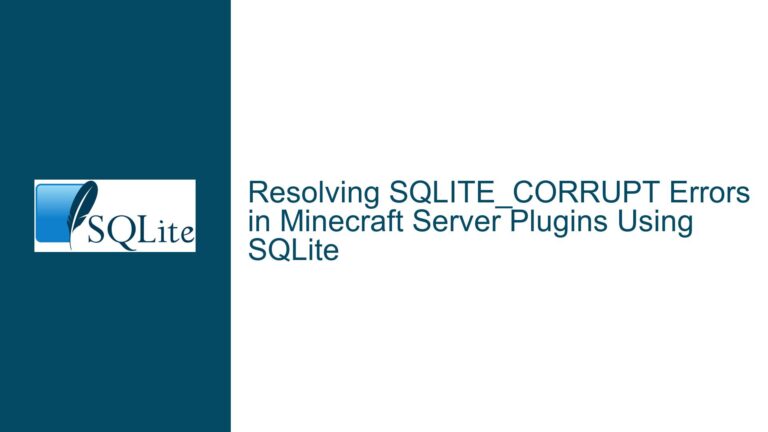SQLite Forking Issues: Snapshot Isolation Failure and Database Corruption
SQLite Database Connection Inheritance Across Forked Processes
When working with SQLite in a multi-process environment, one of the most critical yet often overlooked aspects is how database connections are managed across forked processes. SQLite is designed to be a lightweight, serverless database engine, but this design comes with specific constraints, especially when dealing with process forking. A common mistake is opening a database connection in the parent process and then attempting to use that same connection in a child process after a fork(). This approach can lead to severe issues, including snapshot isolation failures and even database corruption.
Snapshot isolation is a database feature that ensures a transaction sees a consistent view of the data as it existed at the start of the transaction, regardless of changes made by other transactions. In the context of SQLite, this means that a SELECT statement should not see changes made by other processes after the SELECT has begun execution. However, when database connections are improperly inherited across forked processes, this isolation can break down, leading to inconsistent data views.
The core issue arises from how SQLite manages its internal state, including locks and journal files. When a database connection is opened, SQLite initializes various data structures and acquires locks to ensure data integrity. If a process forks after opening a database connection, the child process inherits these locks and data structures. However, the child process does not have a consistent view of the state, leading to potential conflicts and inconsistencies.
Inherited Database Connections and Locking Problems
The primary cause of snapshot isolation failure in SQLite when using forked processes is the inheritance of database connections. SQLite relies on file locks to manage concurrent access to the database. When a parent process opens a database connection, it acquires these locks. If the parent process then forks, the child process inherits the same file descriptors and locks. However, the child process does not have a consistent view of the database state, leading to potential locking problems.
SQLite uses a combination of shared locks, reserved locks, and pending locks to manage concurrent access. When a process reads from the database, it acquires a shared lock. When a process writes to the database, it upgrades to a reserved lock and then to a pending lock before committing the changes. If a child process inherits these locks from the parent, it may attempt to acquire or release locks in a way that conflicts with the parent process, leading to deadlocks or inconsistent data views.
Another issue is the handling of the SQLite journal file, which is used to implement atomic commits and rollbacks. When a database connection is opened, SQLite creates a journal file to track changes. If a child process inherits the journal file descriptor from the parent, it may attempt to write to the journal file in a way that conflicts with the parent process, leading to database corruption.
Additionally, SQLite’s internal state, including the page cache and prepared statements, is not fork-safe. When a process forks, the child process inherits the parent’s memory space, including the SQLite page cache and any prepared statements. However, the child process does not have a consistent view of this state, leading to potential inconsistencies and errors.
Proper Forking Practices and Database Connection Management
To avoid snapshot isolation failures and database corruption when using SQLite in a multi-process environment, it is essential to follow proper forking practices and manage database connections correctly. The key is to ensure that each process, including the parent and child processes, opens its own database connection after the fork. This approach ensures that each process has a consistent view of the database state and avoids conflicts with locks and journal files.
The first step is to ensure that the parent process does not open the database connection before forking. Instead, the parent process should fork first and then open the database connection in both the parent and child processes. This approach ensures that each process initializes its own SQLite state, including locks and journal files, and avoids inheriting inconsistent state from the parent process.
In the parent process, after forking, the database connection should be opened as usual. In the child process, the database connection should also be opened independently. This ensures that each process has its own set of file descriptors, locks, and journal files, avoiding conflicts and inconsistencies.
It is also important to ensure that any prepared statements or other SQLite objects are created after the fork. Prepared statements are tied to the database connection and should not be shared across processes. Each process should prepare its own statements and manage its own SQLite objects to avoid conflicts and inconsistencies.
Another consideration is the use of SQLite’s PRAGMA journal_mode setting. The journal mode determines how SQLite implements atomic commits and rollbacks. In a multi-process environment, the WAL (Write-Ahead Logging) mode is often recommended because it allows concurrent reads and writes and reduces the likelihood of conflicts. However, even with WAL mode, it is essential to ensure that each process opens its own database connection after the fork.
Finally, it is crucial to handle errors and edge cases properly. If a child process encounters an error, it should close its database connection and exit gracefully. The parent process should also handle errors and ensure that it does not attempt to use a database connection that has been closed or corrupted by the child process.
By following these practices, you can avoid snapshot isolation failures and database corruption when using SQLite in a multi-process environment. Proper forking practices and database connection management are essential to ensure data integrity and consistency in a multi-process application.
Implementing PRAGMA journal_mode and Database Backup
In addition to proper forking practices, implementing SQLite’s PRAGMA journal_mode and regular database backups can further enhance data integrity and consistency in a multi-process environment. The PRAGMA journal_mode setting determines how SQLite implements atomic commits and rollbacks, and choosing the right journal mode can significantly impact performance and reliability.
The default journal mode in SQLite is DELETE, which uses a rollback journal to implement atomic commits. In this mode, SQLite creates a separate journal file to track changes, and the database file is updated in place. While this mode is simple and reliable, it can lead to conflicts in a multi-process environment, especially if processes inherit database connections.
The WAL (Write-Ahead Logging) mode is often recommended for multi-process environments because it allows concurrent reads and writes and reduces the likelihood of conflicts. In WAL mode, SQLite writes changes to a separate WAL file instead of updating the database file directly. Readers can continue to access the database file while writers append changes to the WAL file. This approach reduces contention and improves performance in a multi-process environment.
To enable WAL mode, you can execute the following SQL command:
PRAGMA journal_mode=WAL;
This command should be executed after opening the database connection in each process. It is important to note that WAL mode requires SQLite version 3.7.0 or later.
In addition to enabling WAL mode, regular database backups are essential to ensure data integrity and recoverability. SQLite provides several methods for backing up the database, including the sqlite3_backup API and the .dump command. The sqlite3_backup API allows you to create an online backup of the database while it is in use, making it suitable for multi-process environments.
To create a backup using the sqlite3_backup API, you can use the following steps:
- Open the source database connection.
- Open the destination database connection.
- Initialize the backup object using
sqlite3_backup_init(). - Copy the database pages using
sqlite3_backup_step(). - Finalize the backup using
sqlite3_backup_finish().
Here is an example of using the sqlite3_backup API:
sqlite3 *pSource;
sqlite3 *pDest;
sqlite3_backup *pBackup;
// Open the source and destination databases
sqlite3_open("source.db", &pSource);
sqlite3_open("backup.db", &pDest);
// Initialize the backup object
pBackup = sqlite3_backup_init(pDest, "main", pSource, "main");
if (pBackup) {
// Copy the database pages
sqlite3_backup_step(pBackup, -1);
// Finalize the backup
sqlite3_backup_finish(pBackup);
}
// Close the database connections
sqlite3_close(pSource);
sqlite3_close(pDest);
Regular backups ensure that you can recover from data corruption or other issues that may arise in a multi-process environment. It is also a good practice to verify the integrity of the backup using the PRAGMA integrity_check command.
By implementing PRAGMA journal_mode and regular database backups, you can further enhance the reliability and performance of SQLite in a multi-process environment. These practices, combined with proper forking and database connection management, ensure data integrity and consistency in your application.
Conclusion
Managing SQLite in a multi-process environment requires careful attention to forking practices, database connection management, and journal mode settings. Inheriting database connections across forked processes can lead to snapshot isolation failures, locking problems, and database corruption. By ensuring that each process opens its own database connection after the fork, you can avoid these issues and maintain data integrity.
Implementing PRAGMA journal_mode=WAL and regular database backups further enhances reliability and performance in a multi-process environment. The WAL mode allows concurrent reads and writes, reducing contention and improving performance, while regular backups ensure recoverability in case of data corruption or other issues.
By following these best practices, you can effectively use SQLite in a multi-process environment, ensuring data integrity, consistency, and reliability in your application.
